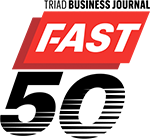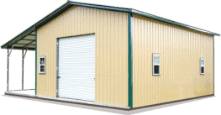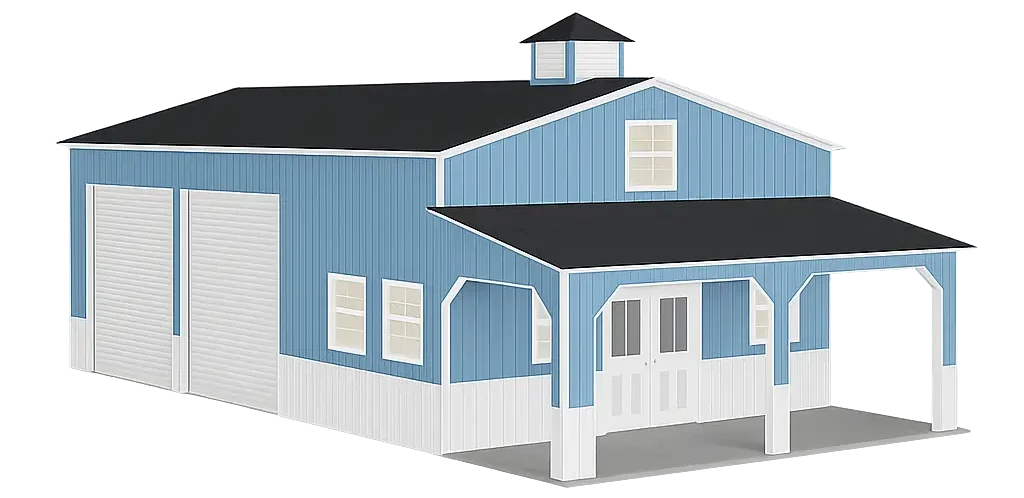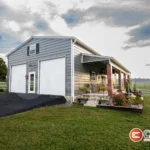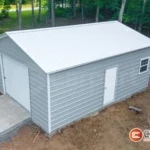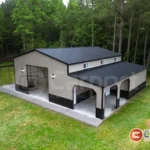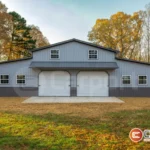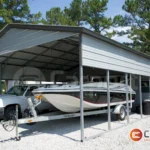22
Understanding Building Codes, Loads, & Occupancy Ratings for Metal Buildings

We talked in a previous blog about how codes and standards have been developed for cold-formed steel as a building material, but there are also some specific engineering and design guidelines that go along with the construction of a metal structure itself. In fact, these sorts of guidelines don’t just apply to metal buildings; all buildings must meet certain building codes, load requirements, and human occupancy ratings, depending on the standards set by each local municipality, county, and/or state. Since buildings are primarily intended to provide reliable shelter for people, possessions, and various applications, each building should be constructed to meet various minimum standards.
That’s quite a load!
In the case of metal buildings, two particular areas of focus for local building codes are loads and occupancy ratings. We’ll start by taking a look at loads. Loads speak to a building’s ability to protect against weights and forces exerted on the building itself (e.g. dead load, live load, collateral load, concentrated load), and upon the building’s ability to protect against specific forces of nature like wind load, snow load, and seismic load. Let’s take a closer look at some of these load categories:
WEIGHTS & FORCES EXERTED ON THE BUILDING
-
-
Dead load
-
This is simply the total weight of the metal building’s permanent structure, including things like framing, roof, paneling, and insulation. Total dead weight is one factor that has to be taken into consideration when measuring a building’s structural integrity.
-
-
Live load
-
While dead load is a measure of permanent structural weight, live load refers to any temporary load placed on a building that isn’t related to weather or other forces of nature. Live load encompasses things like building occupants, furnishings, equipment, materials, and other examples of variable weights.
-
-
Collateral load
-
Collateral load takes into account the weight of other permanent materials that aren’t directly part of the metal building’s support structure. This could include things like sprinklers, ceilings, mechanical systems, electrical systems, or other loads which are distributed evenly across the building.
-
-
Concentrated load
-
A concentrated load is another type of permanent weight that’s independent of a metal building’s support structure. But where a collateral load is evenly distributed, a concentrated load (also known as a point load) is focused in a specific area. The two most common categories of concentrated loads are rooftop loads (e.g. an HVAC unit) and suspended loads (e.g. a space heater that’s suspended from the ceiling).
RESISTANCE TO SPECIFIC FORCES OF NATURE
-
-
Wind load
-
Metal structures should be designed to withstand the forces imposed by wind blowing in from any direction. Many areas across the U.S. have a minimum wind load building code in place. Some regions have more stringent wind codes than others. For example, since Florida has to contend with hurricanes, tornadoes, and other wind events more frequently, the minimum required wind resistance is higher there than in many other states.
-
-
Snow load
-
Snow load takes into account a metal building’s ability to support the vertical load added by the weight of accumulated snow on the roof, as well as the weight of any snow that may drift and accumulate against the side of the building. Obviously, average snowfall varies widely by geographic region, so this can also affect the minimum snow load requirements for a given location.
-
-
Seismic load
-
Some areas are more prone to seismic activity than others, but earthquakes of varying magnitudes can be a possibility in nearly any location. For this reason, many areas do have some minimum seismic load requirements. And one advantage of choosing a steel as a building material is that steel is both stronger and more flexible than wood. A steel structure is better engineered for withstanding earthquake waves than a traditional stick-build.
How many people will that thing hold?
Apart from weights, loads, and environmental forces, another common area of building code focus is human occupancy. An occupancy rating is assigned to a structure based upon the number of people it can safely accommodate. Generally speaking, the more people your building needs to house and protect, the stronger the building needs to be. Buildings typically fall into one of four occupancy categories:
-
-
Low Human Occupancy
-
These are buildings which aren’t intended for public gatherings. Some examples include agricultural structures for various applications like livestock housing, dairy production, horse arenas, and milk production facilities. General storage facilities and buildings designed to house various equipment fall into this category, as well.
-
-
Normal Human Occupancy
-
Most buildings which aren’t specifically designed to accommodate large groups of people will fall into this category. For most permitting offices, Normal Human Occupancy is the default designation given to a building which doesn’t specifically fall under one of the other three categories.
-
-
High/Substantial Human Occupancy
-
These are buildings which are primarily designed for assembly or for accommodating large numbers of people on a regular basis. This includes things like schools, churches, auditoriums, stadiums, and community centers. Manufacturing or storage facilities containing items which are potentially hazardous, toxic, or explosive must also fall under this occupancy rating.
-
-
Post-Disaster/Essential
-
Buildings which are used to provide essential services in the event of a disaster must be constructed in a manner to earn this highest level of designation. Some examples include hospitals, emergency response facilities, power-generating facilities, water treatment facilities, and police & fire stations.
The International Building Code (IBC) further differentiates buildings into ten main occupancy categories, including Assembly, Business, Educational, Factory/Industrial, High Hazard, Institutional, Mercantile, Residential, Storage, and Utility & Miscellaneous. Some buildings include space that may be classified under more than one occupancy group. Multi-use application buildings of this nature are typically referred to as having mixed occupancy.
Carport Central can get you what you need in a reliable steel structure!
Perhaps you find yourself in need of a new building for a specific residential, commercial, agricultural, or industrial application. How do you intend to use your building? What local building codes apply in terms of various loads and occupancy ratings? The good news is that Carport Central is here to provide you with a perfect steel building solution! Every metal structure we provide is custom built-to-order, and we can help you to take every necessary building regulation for your local area into account. Of course, we have a great selection` of metal carports, but that’s really just the tip of the iceberg in terms of what we have to offer. We provide a host of custom steel structure solutions for nearly any application. Whether you may need a garage, barn, utility building, workshop, retail storefront, warehouse, manufacturing facility, production facility, office, or residential space, we’ve got you covered! We even give you the freedom to design and create your own personalized building with our powerful, simple-to-use 3D Building Design Tool on any computer or smart device.
Ready to get the conversation started? You can reach out to us online, or just give us a call at (980) 321-9898 and speak to one of our friendly building experts. And remember, Carport Central is about much more than just selling you a building. We’re about Providing Shelter for Your Way of Life!
Get Started
It's fast and easy. Get your instant quote today!
BLOG TOPICS
- Workshops (7)
- Eagles & Buildings (1)
- Reviews (2)
- Snowfall in the Southeast (2)
- Carports and Buildings Prices (1)
- Reality Of Discounted Buildings (2)
- Snow Removal (1)
- Offers (3)
- Condensation in Metal Buildings (2)
- News & Awards (12)
- Livestock sheds (4)
- Installations (15)
- Metal Buildings Applications (7)
- Customized Buildings (41)
- Carport Sizes (2)
- Facts (1)
- Certified Carports (2)
- COVID-19 (1)
- Prefab Metal Buildings (66)
- Metal Building Homes (6)
- Metal Building of the Week (11)
- Install of the week (1)
- Metal Building Extensions (1)
- Install of the month (2)
- Garages (52)
- Farm Show (1)
- Building Components (1)
- Carports (29)
- Storage Sheds (15)
- Metal Buildings (6)
- Barns (18)
- Metal Homes (8)
- Metal Sheds (1)
- RV Covers (6)
- 12 Gauge Framing (7)
Metal Buildings
- Alabama
- Arizona
- Arkansas
- California
- Colorado
- Connecticut
- Delaware
- Florida
- Georgia
- Idaho
- Illinois
- Indiana
- Iowa
- Kansas
- Louisiana
- Maine
- Maryland
- Massachusetts
- Michigan
- Minnesota
- Mississippi
- Missouri
- Montana
- Nebraska
- Nevada
- New Hampshire
- New Jersey
- New Mexico
- New York
- North Carolina
- North Dakota
- Ohio
- Oklahoma
- Oregon
- Pennsylvania
- Rhode Island
- South Carolina
- South Dakota
- Tennessee
- Texas
- Utah
- Vermont
- Virginia
- Washington
- West Virginia
- Wisconsin
- Wyoming
Metal Garages
- Alabama
- Arizona
- Arkansas
- California
- Colorado
- Connecticut
- Delaware
- Florida
- Georgia
- Idaho
- Illinois
- Indiana
- Iowa
- Kansas
- Louisiana
- Maine
- Maryland
- Massachusetts
- Michigan
- Minnesota
- Mississippi
- Missouri
- Montana
- Nebraska
- Nevada
- New Hampshire
- New Jersey
- New Mexico
- New York
- North Carolina
- North Dakota
- Ohio
- Oklahoma
- Oregon
- Pennsylvania
- Rhode Island
- South Carolina
- South Dakota
- Tennessee
- Texas
- Utah
- Vermont
- Virginia
- Washington
- West Virginia
- Wisconsin
- Wyoming
Metal Carports
- Alabama
- Arizona
- Arkansas
- California
- Colorado
- Connecticut
- Delaware
- Florida
- Georgia
- Idaho
- Illinois
- Indiana
- Iowa
- Kansas
- Louisiana
- Maine
- Maryland
- Massachusetts
- Michigan
- Minnesota
- Mississippi
- Missouri
- Montana
- Nebraska
- Nevada
- New Hampshire
- New Jersey
- New Mexico
- New York
- North Carolina
- North Dakota
- Ohio
- Oklahoma
- Oregon
- Pennsylvania
- Rhode Island
- South Carolina
- South Dakota
- Tennessee
- Texas
- Utah
- Vermont
- Virginia
- Washington
- West Virginia
- Wisconsin
- Wyoming
- 100x100 Metal Building
- 12x12 Metal Shed
- 12x20 Carport
- 12x24 Carport
- 12x30 Carport
- 16x20 Carport
- 18x20 Carport
- 20x20 Carport
- 20x20 Metal Building
- 20x30 Carport
- 20x30 Metal Building
- 20x40 Carport
- 20x40 Metal Building
- 24x24 Carport
- 24x24 Garage
- 24x30 Carport
- 24x30 Metal Building
- 24x30 Metal Garage
- 24x36 Metal Building
- 26x30 Metal Building
- 30x30 Carport
- 30x30 Garage
- 30x30 Metal Building
- 30x40 Carport
- 30x40 Garage
- 30x40 Metal Building
- 30x40 Storage Building
- 30x50 Metal Building
- 30x60 Metal Building
- 40x100 Metal Building
- 40x40 Metal Building
- 40x60 Metal Building
- 40x80 Metal Building
- 50x100 Metal Building
- 50x50 Metal Building
- 50x80 Metal Building
- 60x100 Metal Building
- 60x120 Steel Building
- 60x60 Metal Building
- 60x80 Metal Building
- 80x100 Metal Building
- All Steel Carports
- American Building Network
- American Custom Carports
- American Steel Carports
- Arkansas Carports
- Best Choice Metal Structures
- California All Steel
- Carports Outlet
- Central Texas Metal Buildings
- Coast To Coast Carports
- Custom Steel Structures
- Dreams Carports and Buildings Inc
- East Coast Carports
- Enterprise Steel Structures
- Infinity Carports
- Interstate Steel Structures
- Long Horn Buildings
- Midwest Steel Carports
- NC Structures
- New Team Carports
- Northside Metal Carports
- Quality Carports
- Rhino Carports
- Safeguard Metal Buildings
- Southern Steel Buildings Inc.
- Steel Buildings and Structures
- Tennessee Steel Buildings
- Tubular Building Systems
- Ultimate Metal Buildings
- United Structures
- USA Carports


